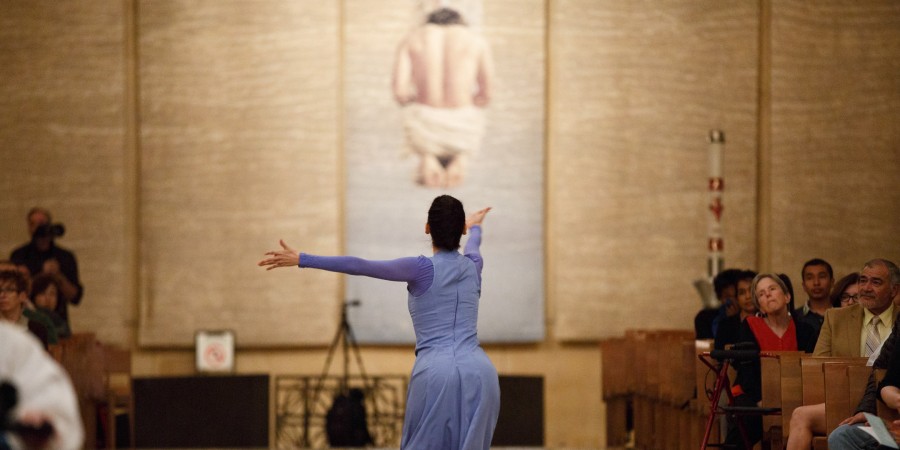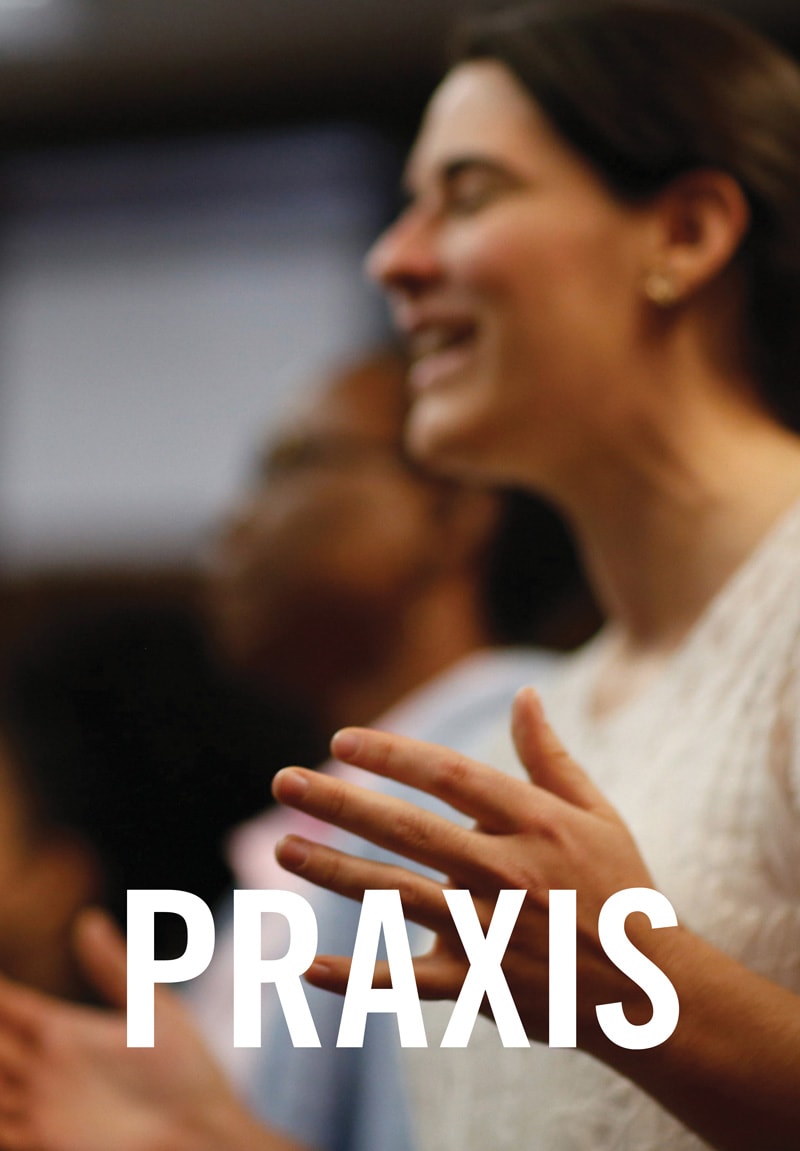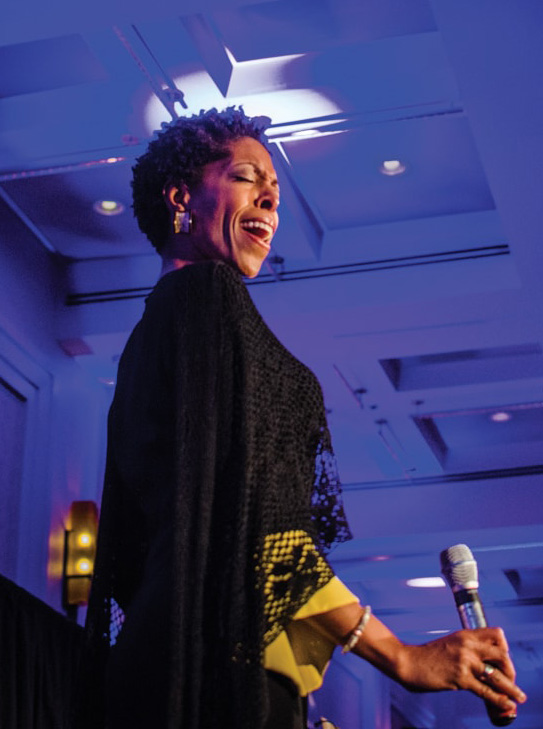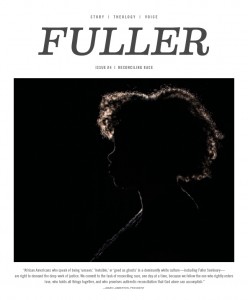
“Christian worship as a peculiar culture can be defined as a patterned relationship between God and humans and its embodiment in a liturgical manner and form. Moreover, this patterned relationship between God and humans and its embodiment does not have a fixed form, but is rather a process—an ongoing creative work of human beings. Christian worship is not a ready-made fixed form, but is rather a creative process, a holy conversation in a patterned relationship between God and God’s people.”
+ Jonghun Joo [PhD ’11] teaches at Africa International University in Kenya, and coteaches “Practice of Worship and Prayer” with Ed Willmington in Fuller’s Korean Studies Program. Above: a dancer interprets hymns at the Brehm Center’s Festival of Worship held at the Cathedral of Our Lady of the Angels in Los Angeles, California.
“I believe that where God desires for us to go as believers is that place where we can do all of the music . . . there’s nothing wrong with having a hymn and a worship song and something that’s salsa-like, and then something with Jewish popular beats. It might not happen in your church in one service. Maybe you do have to have a couple of different services, but the issue is that the hearts of the people are saying, ‘We understand that our coming together is about God and not about our tastes. . . . ’ What we do when we get together, in order for God to be glorified, the flesh has to be brought down.”
+ (at left) from Diane White-Clayton, choral conductor of Faithful Central Bible Church in LA, who sang and spoke at the dedication gala celebrating the William E. Pannell Center for African American Church Studies.
“Worship at Fuller is unique—we’re not a church, so we’re able to focus on our Fuller community . . . a community that is generally more diverse theologically, ethnically, and denominationally than a typical local congregation. Our goal is that corporate worship would be a central, formative part of the life of the Fuller community. From the Brehm Center’s perspective, we’re asking, ‘how can we contribute assistance to help create artistic, theologically forming worship experiences inside the Fuller community?’ One way we’re answering that is through the Brehm New Music Initiative, a new initiative to empower worship leaders to develop resources for worshiping communities.”
+ Ed Willmington is the Director of the Fred Bock Institute of Music of the Brehm Center for Worship, Theology and the Arts, and Composer-in-Residence at Fuller Theological Seminary. Pictured below (left to right) is a Centro Latino worship service, a panel about art and justice with Jars of Clay at Fuller Northwest, and a Korean language worship service—all examples of worship expressions at our campuses.

YOUTH
“If one out of two young people walk away from faith in the church after high school, why is it that some stay and what can we learn? What can we do better as congregations? . . . When we looked at different variables and what’s actually connected in our research with faith that sticks across that transition, intergenerational worship was one of the ones that rose to the top. And what we learned was that young people who actually worshiped alongside their parents or other adults in the congregations tended to stick with faith more than those who didn’t have those opportunities.”
+ Brad Griffin, associate director of the Fuller Youth Institute, interviewed by alum Eric Mathis [PhD ’13] at anima: the Forum for Worship & the Arts at Samford University.
EDUCATION
“To be fully effective in the worship service, music must be planned carefully in concert with the service, as expressed in the sermon or biblical readings, so that the result is an integrated whole for the parishioner. Such planning requires skill, training, and practice, with nothing taken for granted. It is with this in mind that Fuller Seminary created a center for Worship, Theology, and the Arts—an entity aimed at bringing the arts back into the sanctuary.”
+ Bill Brehm, the founder of the Brehm Center for Worship, Theology, and the Arts. He and his wife, Dee, have recently funded the Brehm New Music Initiative to encourage creative production of new worship music for churches.
HISTORY
“The liturgical renewal movement is the result of the discovery of ancient worship forms, but it is not simply an antiquarian interest that has spurred such changes. There is a recovery of the whole eschatological awareness—that truly the new creation has broken into the old, that as Christians we are now living with a foretaste of the future kingdom, that communion is a joyful feast of the people of God. We are a people of hope who have a joyful message for the whole world.”
+ Catherine Gunsalus González, from her Brehm Lecture “Worship: What Does the Future Have to Do with the Past?” as part of the Centro Latino 40th anniversary celebration in 2014.
PSYCHOLOGY
“Is there a behavioral change in worship? Drawing on the undoing hypothesis of Fredrickson’s Broaden and Build Theory of Positive Emotion, Charlotte Witvliet and I posited that worship not only had a positive impact on participants but this positivity could ‘undo’ negative emotional experiences— especially in experiences of confession and divine forgiveness. After analyzing the data, we found that when people talked about experiences of forgiveness in worship, they talked about negative and positive emotions. It’s a mixed emotional experience, but people were still finding God’s forgiveness in the midst of it.”
+ Alexis D. Abernethy, professor of psychology, describing her recent research on the integration of forgiveness, worship, and psychology.
“Worship is this time when we are weaving all of our human stories—as individuals, as a community, as a world—into a divine story of redemption through Christ. It is in that interweaving, that entering into a narrative, that we can find hope and healing. It can bring people from different places together as we recognize that we’re all part of one story, but if we don’t think about how we are participating or how we’re facilitating participation, it can just be a presentation.”
+ Nicholas Zork [MAT ’09], a songwriter and worship leader, in an interview with Seventh-day Adventist news magazine Record about planning services and creativity in worship.

JUSTICE
“The heart of the battle over worship is this: our worship practices are separated from our call to justice, and, worse, foster the self-indulgent tendencies of our culture rather than nurturing the self- sacrificing life of the kingdom of God. We are asleep. Nothing is more important than for us to wake up and practice the dangerous act of worship, living God’s call to justice.”
+ Mark Labberton, in his book The Dangerous Act of Worship.
PSALMS
“In Practice of Worship and Prayer, we have spent a lot of time considering the Psalms as the primary resource for Christian worship and prayer. Recently our professor said that Psalms 4 and 5 are a pair: one an evening Psalm and the other a morning Psalm. Excited and intrigued, I asked: ‘How do we know that?’ There are no special titles or footnotes, asterisks or big arrows in the text that would alert the reader to this kind of information. The response to my question was equally brief: ‘You read the Psalms!’ Which of course is exactly the point of this class. If the Psalms are our best resource for prayer, we will engage them well by reading them often and especially by doing so in community.”
+ Andrew Herbert [MDiv student], reflecting on the class Practice of Worship and Prayer on the Touchstone Blog—stories from students taking Fuller’s new vocation and formation classes.
DISCERNMENT
“What if the tensions and struggles we are facing represent a providential opening to recover spiritual resonance? Christian practices of worship are often criticized because they are captive either to simple traditionalism or to the search for new and entertaining forms of expression. In either case, there is healthy recognition that these forms ought to be carriers of spiritual power. We must recover an understanding of Christian worship as providing symbolic resonance and theological depth . . . [so that] the symbolic depth of Christian practices might provide a winsome contrast to the superficial culture of entertainment that surrounds us, even as it also satisfies the spiritual longings of our contemporaries.”
+ William A. Dyrness in his book A Primer on Christian Worship: Where We’ve Been, Where We Are, Where We Can Go.
TIME
“Perhaps sacred space is found by praying the Hours behind the wheel of your car as you inch through the traffic of your morning commute. God will meet you there. Even there, we can take time to reinterpret, to reimagine the space for prayer. Your car is no longer just a metal box with switches and gears controlled by the human hand. It is a space overflowing with the presence of the Spirit of God, the very One who moved over the face of the waters at the earth’s inception.”
+ Nate Risdon [MDiv ’07], associate director of the Brehm Center, from his reflections on liturgical prayer in the book Praying the Hours in Ordinary Life.
LEADER: As we gather in this place, remind us that Christ’s prayer of oneness is still a dream that lies ahead of us. Forgive us for the energies we put into denominationalism, factionalism, and nationalism that draw your body in the world asunder.
ALL: Lord, have mercy.
LEADER: For the churches represented in this congregation and in this choir, grant peace and continued hope for their ministries, and draw us together in your mercy, in your hope, and in your love.
ALL: Lord, have mercy.
LEADER: The prayers of your children, the triumphant dancing, the shouts of praise will never ring as loudly, and move as rhythmically, or speak as poetically as when we will all gather together on that final day. Prepare our hearts for that joy and grant us glimpses of the blessed kingdom to come.
ALL: Lord, have mercy.
+ A prayer from the 2015 Festival of Worship, sponsored by the Brehm Center’s Fred Bock Institute of Music and the Cathedral of Our Lady of the Angels. Bock Institute Director Ed Willmington is pictured conducting a choir of over 800 voices representing 40 different congregations. Ed is the Composer-in-Residence at Fuller Theological Seminary.
Spiritual Resources
Korean Morning Prayer Meeting
African Prayer Fellowship
Thursday Worship & Fellowship
+ available at Fuller Pasadena
Further Reading
Worship that Changes Lives: Multidisciplinary and Congregational Perspectives on Spiritual Transformation
edited by Alexis D. Abernethy (Baker Academic, 2008)
A Primer of Christian Worship: Where We Have Been, Where We Are, and Where We Can Go
William A. Dyrness (Eerdmans, 2009)
Senses of the Soul: Worship and the Visual in Christian Worship
William A. Dyrness (Cascade Books, 2008)
The Conviction of Things Not Seen: Worship and Ministry in the 21st Century
edited by Todd E. Johnson (Brazos, 2002)
Living Worship: A Multimedia Resource for Students and Leaders
James Caccamo, Todd E. Johnson, and Lester Ruth (Brazos Press, 2010)
The Dangerous Act of Worship: Living God’s Call to Justice
Mark Labberton (InterVarsity Press, 2007)
Available Classes
Worship and World Religions with Sooi Ling Tan
Music, Peacebuilding, and Interfaith Dialogue with Roberta King
Theology, Worship, and Art with William Dyrness
Theological Method for Worship and the Arts with Todd Johnson
Worship Leadership: Formation and Skill with Ed Willmington
Worship Ministry on the Lord’s Day with Todd Johnson
Anglican Liturgy and Worship with James Henry Steven
Practice of Worship and Prayer with Catherine Barsotti (and other faculty)




